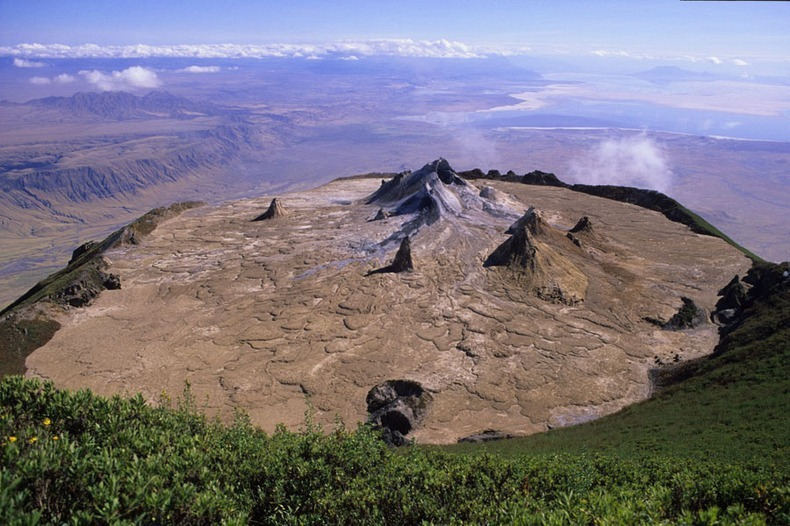Mountain of God volcano, known scientifically as Ol Doinyo Lengai, has recently been observed showing troubling signs of potential volcanic activity. A new study reveals that the land surrounding this unique volcano in Tanzania is bulging, indicating that magma may be accumulating in a shallow reservoir beneath the surface.
This development could be a precursor to a significant eruption, raising concerns among researchers and local authorities.
The term “Mountain of God” refers to Ol Doinyo Lengai, a distinctive volcano that erupts the runniest lava on Earth. Recent satellite data have shown that since March 2022, a magma reservoir located approximately 1.4 miles (2.3 kilometers) below the crater has been swelling, causing the Earth’s crust above it to stretch.
This phenomenon of land deformation continued rapidly until December 2022, followed by a period of slower uplift that persisted until August 2023. Researchers are closely monitoring these changes as they may signal an impending eruption.
The Significance of the Bulge at Mountain of God Volcano
Ol Doinyo Lengai is notable for its carbonatite lava, which is exceptionally thin and rich in alkali elements like calcium and sodium. This lava turns bone white upon cooling due to the formation of calcite and other carbonate minerals. The recent bulging observed at the Mountain of God volcano is particularly concerning because it suggests that magma is rising closer to the surface, which could lead to an eruption.
Researchers from Virginia Tech’s Geodesy and Tectonophysics Laboratory, led by doctoral student Ntambila Daud, have used satellite data to measure land deformation around Ol Doinyo Lengai. Their analysis revealed that the rate of land uplift in early 2022 was significantly faster compared to the slower rate observed later in the year and into 2023.

This rapid uplift could indicate magma accumulation in a shallow magma source or increased pressure within a magmatic conduit beneath the volcano’s vent.
The findings from this study, published on July 9 in the journal Geophysical Research Letters, highlight the potential for a significant eruption. The study’s results underscore the importance of continued monitoring and analysis to understand the dynamic magma plumbing system of Ol Doinyo Lengai. The researchers’ computer models revealed clear patterns of uplift that could be critical in predicting future volcanic activity.
Implications for Local Communities and Tourism
The potential for a massive eruption at Mountain of God volcano poses several risks. Eruptions can be hazardous to people living in the vicinity, disrupt local tourism, and affect air traffic in the region. The recent bulging of the land around Ol Doinyo Lengai raises concerns about the safety of nearby communities and the need for preparedness in the event of an eruption.
Reports indicate that lava flows erupted from the summit of Ol Doinyo Lengai as recently as 2021. With the recent observations of land deformation, there is an increased urgency to assess the volcano’s behavior and implement precautionary measures to protect residents and visitors.
Understanding the patterns of magma movement and the likelihood of an eruption is crucial for effective disaster preparedness and risk mitigation.
The research conducted by Daud and her colleagues provides valuable insights into the behavior of Ol Doinyo Lengai and highlights the need for ongoing surveillance of volcanic activity. The use of satellite-connected sensors and computer models has proven essential in detecting changes in the volcano’s magma reservoir and predicting potential eruptions.
Future Research and Monitoring Efforts
The discovery of the bulging around Mountain of God volcano marks a significant advancement in volcanic research. The approach used in this study has enhanced our understanding of the dynamic magma plumbing system and could lead to further discoveries about volcanic activity.
Researchers are optimistic that continued monitoring and analysis will provide more accurate predictions of volcanic eruptions and improve safety measures for affected areas.
As the situation at Ol Doinyo Lengai evolves, it is crucial for scientists, local authorities, and communities to stay informed and prepared. The insights gained from this study will contribute to better understanding the volcano’s behavior and help mitigate the risks associated with potential eruptions.
The ongoing research at Mountain of God volcano underscores the importance of vigilance and preparedness in the face of volcanic hazards. By leveraging advanced technologies and research methods, scientists are making strides in predicting and managing volcanic activity, ultimately safeguarding lives and property.

